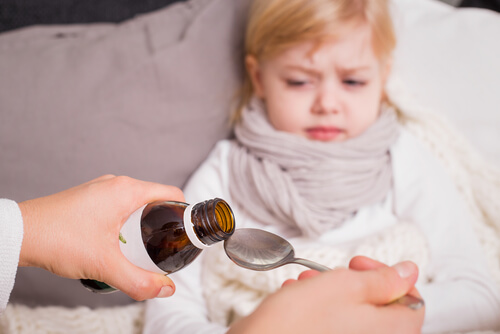Worms in Children: What to Do?

Here we’ll talk about how to detect, prevent and treat worms in children. Also called pinworms, worms are small parasites that children sometimes contract. Their scientific name is Enterobius vermicularis.
Their appearance is that of a small, thin worm approximately 1 centimeter long. They are whitish or gray in color, and they move. They lodge in the large intestine, anus and, in the case of girls, the outer part of the vagina.
Symptoms of worms in children
- The most common symptom that children have is an intense itching in the area of the anus.
- Girls may also experience itching in the vagina, as it is very close to the anal area and infection there is quite common.
- Girls may also have unusual vaginal discharge.
- Little ones may suffer burning or discomfort while urinating, and this can make a worm infestation confused with cystitis or another type of urinary infection.
- Itching occurs or intensifies during the night, because that is when the females lay their eggs. They can lay up to 20,000 eggs daily.
- Eruptions on the skin occur when children experience the imperative need to scratch.
- Itching prevents the child from falling asleep or wakes him or her up in the middle of the night.
- Lack of appetite. The child may have abdominal discomfort. Fatigue from lack of sleep can also decrease appetite.
- Apathy. Difficulty sleeping due to the itching makes the child wake up exhausted.
- Grinding teeth during sleep is typically a habit that occurs when someone is stressed, but when dealing with worms in children, it occurs due to the discomfort of intense itching.
- Some children also experience a high temperature.
How are children infected with worms?
The contagion begins with itching. The child scratches himself, and as he is not yet aware of the importance of washing his hands or of the possibility of contracting diseases, he puts his hands in his mouth.

It is also possible to transfer the worm eggs from one’s hands to any object, which can then be put in the mouth. This type of behavior is normal during the early years of childhood. Other family members can also become infected through the objects.
How to detect worms in children
There are several methods. The simplest is to look at the child’s stool. If small worms appear, he has contracted worms.
The mother can also carefully observe the anus area by spreading the child’s buttocks. If the child is infected with worms and this procedure is done at night, the mother will probably be able to see the parasites.
Another method is to use strips of an adhesive paper created for this purpose. The paper is placed on the anus and removed after a certain period of time, then observed under a microscope.
Treating worms in children
Eliminating worms in children is quite simple. A medication is administered orally. It’s usually just one dose, which some pediatricians recommend repeating after about 20 days in order to eliminate the parasites that were in eggs and survived the initial treatment.

Some specialists recommend administering the treatment to everyone who lives with the child in order to avoid the spread of the parasites, especially to anyone who shares a bed or bedroom with the child.
It should be noted that the medicines used to treat worms are not antibiotics, since worms are not bacteria.
Skin lesions caused by scratching may also be treated. There are soothing and anti-inflammatory creams and ointments for this purpose. In the event of more serious injuries, a pediatrician must evaluate whether the lesions are infected and prescribe an antibiotic ointment.
Preventing infection
Here are some recommendations to avoid contracting worms in children and the rest of the family:
- Do not shake clothes, as the eggs of the worms can be strewn around the room.
- Wash all the child’s linens and clothes with hot water: towels, sheets, covers, and especially underwear. Do this often.
- Use antibacterial detergents.
- Encourage the habit of washing one’s hands after going to the bathroom and before eating. It is important for parents to watch that the child does it appropriately and every time.
- Cut fingernails and clean under them with a special brush for this purpose.
- Prevent the child from sucking his fingers
- Teach the child not to put objects in his or her mouth.
Here we’ll talk about how to detect, prevent and treat worms in children. Also called pinworms, worms are small parasites that children sometimes contract. Their scientific name is Enterobius vermicularis.
Their appearance is that of a small, thin worm approximately 1 centimeter long. They are whitish or gray in color, and they move. They lodge in the large intestine, anus and, in the case of girls, the outer part of the vagina.
Symptoms of worms in children
- The most common symptom that children have is an intense itching in the area of the anus.
- Girls may also experience itching in the vagina, as it is very close to the anal area and infection there is quite common.
- Girls may also have unusual vaginal discharge.
- Little ones may suffer burning or discomfort while urinating, and this can make a worm infestation confused with cystitis or another type of urinary infection.
- Itching occurs or intensifies during the night, because that is when the females lay their eggs. They can lay up to 20,000 eggs daily.
- Eruptions on the skin occur when children experience the imperative need to scratch.
- Itching prevents the child from falling asleep or wakes him or her up in the middle of the night.
- Lack of appetite. The child may have abdominal discomfort. Fatigue from lack of sleep can also decrease appetite.
- Apathy. Difficulty sleeping due to the itching makes the child wake up exhausted.
- Grinding teeth during sleep is typically a habit that occurs when someone is stressed, but when dealing with worms in children, it occurs due to the discomfort of intense itching.
- Some children also experience a high temperature.
How are children infected with worms?
The contagion begins with itching. The child scratches himself, and as he is not yet aware of the importance of washing his hands or of the possibility of contracting diseases, he puts his hands in his mouth.

It is also possible to transfer the worm eggs from one’s hands to any object, which can then be put in the mouth. This type of behavior is normal during the early years of childhood. Other family members can also become infected through the objects.
How to detect worms in children
There are several methods. The simplest is to look at the child’s stool. If small worms appear, he has contracted worms.
The mother can also carefully observe the anus area by spreading the child’s buttocks. If the child is infected with worms and this procedure is done at night, the mother will probably be able to see the parasites.
Another method is to use strips of an adhesive paper created for this purpose. The paper is placed on the anus and removed after a certain period of time, then observed under a microscope.
Treating worms in children
Eliminating worms in children is quite simple. A medication is administered orally. It’s usually just one dose, which some pediatricians recommend repeating after about 20 days in order to eliminate the parasites that were in eggs and survived the initial treatment.

Some specialists recommend administering the treatment to everyone who lives with the child in order to avoid the spread of the parasites, especially to anyone who shares a bed or bedroom with the child.
It should be noted that the medicines used to treat worms are not antibiotics, since worms are not bacteria.
Skin lesions caused by scratching may also be treated. There are soothing and anti-inflammatory creams and ointments for this purpose. In the event of more serious injuries, a pediatrician must evaluate whether the lesions are infected and prescribe an antibiotic ointment.
Preventing infection
Here are some recommendations to avoid contracting worms in children and the rest of the family:
- Do not shake clothes, as the eggs of the worms can be strewn around the room.
- Wash all the child’s linens and clothes with hot water: towels, sheets, covers, and especially underwear. Do this often.
- Use antibacterial detergents.
- Encourage the habit of washing one’s hands after going to the bathroom and before eating. It is important for parents to watch that the child does it appropriately and every time.
- Cut fingernails and clean under them with a special brush for this purpose.
- Prevent the child from sucking his fingers
- Teach the child not to put objects in his or her mouth.
All cited sources were thoroughly reviewed by our team to ensure their quality, reliability, currency, and validity. The bibliography of this article was considered reliable and of academic or scientific accuracy.
- Apt, B. W. (2014b). Infecciones por parásitos más frecuentes y su manejo. Revista Médica Clínica Las Condes, 25(3), 485-528. https://www.sciencedirect.com/science/article/pii/S0716864014700653?via%3Dihub
- Guerra Macías, I., Martínez Sariol, E., García Céspedes, M., Suárez Guerra, J., & Suárez Guerra, J. (2021). Ascariasis complicada en un infante. Revista Cubana de Pediatría, 93(3). https://revpediatria.sld.cu/index.php/ped/article/view/1160/995
- Wendt, S., Trawinski, H., Schubert, S., Rodloff, A. C., Mössner, J., & Lübbert, C. (2019). The Diagnosis and Treatment of Pinworm Infection. Deutsches Arzteblatt international, 116(13), 213–219. https://pubmed.ncbi.nlm.nih.gov/31064642/
- Cevallos, R., Et al. (2019). Tratamiento de parasitosis intestinal en niños menores de 5 años. RECIAMUC, 3(1), 722-749. https://www.reciamuc.com/index.php/RECIAMUC/article/view/255
- Fillot, M., Et al. (2015). Prevalencia de parásitos intestinales en niños del Área Metropolitana de Barranquilla, Colombia. Rev Cubana Med Trop vol.67 no.3 Ciudad de la Habana.http://scielo.sld.cu/scielo.php?pid=S0375-07602015000300002&script=sci_arttext&tlng=en
- Prieto, L., Et al. (2016). Geohelmintos. Enferm Infecc Microbiol Clin.Vol. 34. Núm. 6. Páginas 329-396. https://www.elsevier.es/es-revista-enfermedades-infecciosas-microbiologia-clinica-28-articulo-geohelmintos-S0213005X16000690
- Mayo Clinic. (2022). Infección por parásitos intestinales. Consultado el 09 de mayo de 2023. https://www.mayoclinic.org/es-es/diseases-conditions/pinworm/diagnosis-treatment/drc-20376386
- MedlinePlus. (2017). Mebendazol. Consultado el 09 de mayo de 2023. https://medlineplus.gov/spanish/druginfo/meds/a682315-es.html#:~:text=El%20mebendazol%20(Emverm)%20se%20usa,Funciona%20matando%20las%20lombrices.
This text is provided for informational purposes only and does not replace consultation with a professional. If in doubt, consult your specialist.








